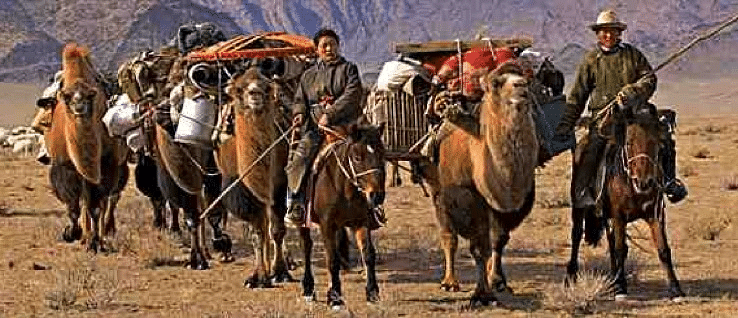NCERT Solutions for Class 11 History - Nomadic Empires
Q1: Why was trade so significant to the Mongols?
Ans: The Mongols had limited resources in the steppes due to which they had to establish a trade relationship with the Chinese. The main commodities that were imported from China were iron utensils and agricultural produce.
The Mongols exported horses and furs that were trapped from the steppes to China. This commerce, however, was not always smooth as there was constant competition for prices and profits.
 Nomadic Empire
Nomadic Empire
Ans: Genghis Khan felt the need of fragmentation of the Mongol tribes into new social and military groupings on account of the following reasons:
(i) Mongols were their own separate identities and were the inhabitants of the steppe region. Genghis Khan wanted to bring them in contact with other tribals through social grouping or ties like a mirage with other tribal communities.
(ii) Mongols were very brave taking the advantage of their bravery Genghis Khan organized them into military groups and established a formidable empire.
Q3: How do later Mongol reflections on the yasa bring out the uneasy relationship they had with the memory of Genghis Khan.
Ans: At the 1206 Assembly of Mongol Chieftains (quriltai), Genghis Khan promulgated Yasa (the code of law). It has gone into detail about the complicated manner in which the Great Khan’s memory was shaped by his successors. The name was originally spelled as yasaq, which signified “law,” “decree,” or “order.” Yasa is concerned with administrative restrictions, such as hunting, the army, and the postal system.
Q4: ‘If history relies upon written records produced by city-based literati, nomadic societies will always receive a hostile representation.’ Would you agree with this statement? Does it explain the reason why Persian chronicles produced such inflated figures of casualties resulting from Mongol campaigns?
Ans: Yes, I agree with the statement. I give the following reasons for my view:
(i) Persian chronicles produced inflated figures of casualties resulting from Mongol campaigns to prove their cruelty or to prove them as cruel assassins.
(ii) There was a vast difference between The Secret Society of Mongols and Macro Polo’s Travelogues in terms of event and their descriptions.
(iii) Being the transcontinental span of the Mongol empire, the sources were written in different languages.
Answer in Essay
Q5: Keeping the nomadic element of the Mongol and Bedouin societies in mind, how, in your opinion, did their respective historical experiences differ? What explanations would you suggest account for these differences?
Ans: The steep dwellers themselves usually produced no literature, so our knowledge of nomadic societies under Mongol are quite different and the Italian and Latin version of Marco Polo’s travels to the Mongol court do not match. Since the Mongol produce little literature of their own and were instead ‘Written about’ by literati from foreign cultural milieus, historians have to often double as a philologist to pick out the meanings of phrases for their closest approximation to Mongol usage. The work of scholars like Igor de Rachewiltz on 'The secret of History' of the Mongol and Gerhard Doerfer on Mongol and Turki terminologies that infiltrated into the Persian language brings out the difficulties involved in studying the history of the central Asian nomads. Despite their incredible achievement there is much about Genghis Khan and the Mongol world empire still awaiting the diligent scholar’s scrutiny.
Q6: How does the following account enlarge upon the character of the Pax Mongolica created by the Mongols in the middle of the thirteenth century?
The Franciscan monk, William of Rubruck, was sent by Louis IX of France on an embassy to the great Khan Mongke’s court. He reached Karakorum, the capital of Mongke, in 1254 and came upon a woman from Lorraine (in France) called Paquette, who had been brought from Hungary and was in the service of one of the prince’s wives who was a Nestorian Christian. At the court, he came across a Parisian goldsmith named Guillaume Boucher, ‘whose brother dwelt on the Grand Pont in Paris’. This man was first employed by Queen Sorghaqtani and then by Mongke’s younger brother. Rubruck found that at the great court festivals, the Nestorian priests were admitted first, with their regalia, to bless the Grand Khan’s cup, and were followed by the Muslim clergy and Buddhist and Taoist monks…
Ans: Mongol rulers were not fanatics and were anxious to get the blessings of all the people. They recruited administrators and armed forces from people of all ethnic groups and religions. There was a multilingual, multi-religious regime that did not feel threatened by its pluralistic constitution. It became clear that the French Monarch Louis IX had sent his ambassador William of Rubruck to the Karakorum, the capital of Mongke in 1254 this depicts that Mongol rulers had established a well-knit with their neighbors. Guillaume Boucher provides that Mongol rulers lived with great pomp and show and they had brought servants to serve them from different parts of the world. They were paid good salaries. That is why they reached to serve the Mongol court from far away.
|
27 videos|151 docs|27 tests
|
FAQs on NCERT Solutions for Class 11 History - Nomadic Empires
| 1. What were the main characteristics of nomadic empires? |  |
| 2. How did nomadic empires influence trade in ancient times? |  |
| 3. What were the major nomadic empires in history? |  |
| 4. How did the lifestyle of nomadic tribes differ from settled societies? |  |
| 5. What role did religion play in nomadic empires? |  |

















